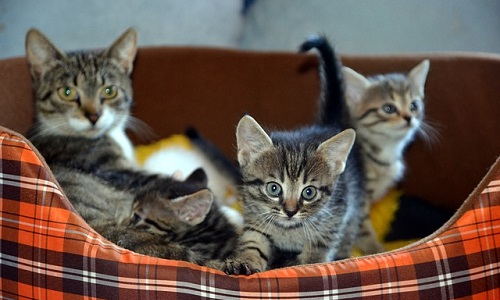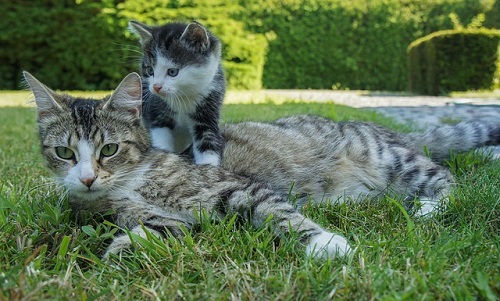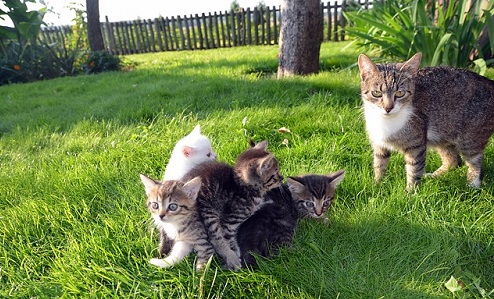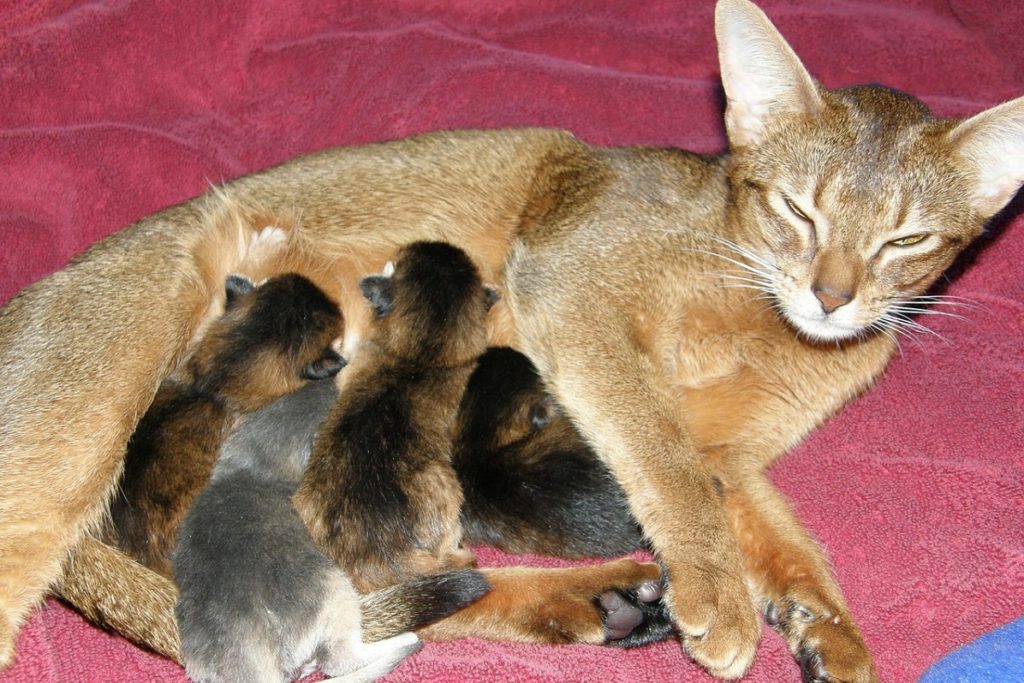For anybody who loves cats, the mere sight of a fuzzy kitten is enough to make one melt. But in the instance where your beloved feline friend may be unexpectedly pregnant, it can pose a host of questions, as well as legitimate concerns – particularly if it’s the first time you’ve owned a cat. In some cases, the prospect of a litter of kitties is welcome news to pet owners. However, it can sometimes create problems, especially if your cat has preexisting health conditions, is too young to carry a litter without posing a medical risk to the mother (and babies), or simply because you don’t have the physical space in your household for more than one or two pets. In any case, it’s important as a pet parent to know how to identify the symptoms of pregnancy in your cat, especially for new pet owners who may be unfamiliar with how to tell if a cat is pregnant. This article will discuss the signs a cat is pregnant as well as the symptoms, and cover how to care for your fur baby during her pregnancy.
An Ounce of Prevention: Understanding Feline Reproduction
One of the first things to keep in mind when owning a cat is if it’s an indoor or outdoor cat – because cats are very prolific breeders, an unspayed female that frequently goes outside can get pregnant during a single encounter. In fact, a cat can continue to go into heat every 2-3 weeks from the onset of spring through the early fall, allowing them to reproduce frequently. Additionally, it should be noted that even kittens may become pregnant as young as four months old; since their pregnancy lasts approximately 65 days, your cat can deliver her first litter when she’s only 6 months old. Furthermore, unlike humans, cats do not go through menopause – they can reproduce until the day they die; an unspayed cat can produce a litter every 12 weeks.
On the other hand, some folks believe that if they keep their cat inside, it’s not necessary to spay their cat; however, it’s not in your pet’s best interest. When a female cat repeatedly goes into heat, she will become extremely frustrated, which often leads to destructive behavior and even biting. Delaying the spaying process for your pet can also become expensive for cat owners – the longer you wait, the more difficult (and costly) the surgery becomes. More importantly, your cat’s quality of life may suffer, as she will not only be faced with behavioral difficulties (which in turn can affect the relationship between you and your pet), but health complications may arise. Certain types of mammary tumors, uterine infections and other physiological problems can occur when spaying is delayed.
 Keeping all of this information in mind, if you don’t want unplanned pregnancies, it’s wise to have your cat spayed at an early age – speak with your veterinarian during your kitten’s check-ups early on to avoid cat pregnancy. In addition to helping control the pet population, some studies show that spaying your cat at a young age can help to prevent numerous diseases, which may have a direct impact on your pet’s life expectancy.
Keeping all of this information in mind, if you don’t want unplanned pregnancies, it’s wise to have your cat spayed at an early age – speak with your veterinarian during your kitten’s check-ups early on to avoid cat pregnancy. In addition to helping control the pet population, some studies show that spaying your cat at a young age can help to prevent numerous diseases, which may have a direct impact on your pet’s life expectancy.
Common Signs Your Cat Is Pregnant: A Pet Owner’s Guide
Now that we’ve covered measures for feline pregnancy prevention, let’s review the tell-tale signs to determine if your cat is pregnant. Here are the major symptoms and physical characteristics to look for:
- Change in nipple color: At approximately 3 weeks into your cat’s pregnancy, your cat’s nipples will darken in color and become enlarged in appearance. Referred to as “pinking up” by veterinarians, this is a normal symptom of pregnancy. Other related signs might include a milky discharge; however, cats don’t begin producing milk until after giving birth.
- Feline morning sickness: Believe it or not, your feline companion might go through a phase of getting sick in the morning – much like humans do. While not every cat experiences morning sickness, be sure to monitor her health carefully throughout the pregnancy and keep track of any unusual symptoms. Contact your family vet right away if the vomiting is excessive or she appears ill.
- Swollen abdomen: By day 30 or so, a pregnant cat will begin to develop an abdomen that appears swollen and rounded after she’s mated; however, her belly may not always be readily noticeable, particularly if your cat is overweight. Depending on the number of kittens your pet is carrying, she may gain between two to four pounds during pregnancy.
- Nesting in preparation for delivery: During the last two weeks of your cat’s pregnancy, she may begin to prepare her area for giving birth; this is referred to as “nesting”. This instinctual behavior typically involves the cat locating a quiet spot where she feels safe; she may arrange blankets or other soft materials in anticipation of delivery. In addition, you may notice changes in your cat’s behavior – she might show more affection than usual, purr more often and even display maternal instincts. However, she may also become less patient with other household pets or animals.
While these may be the most commonly-seen characteristics in pregnant cats, the surest way to know if your cat is expecting is to take her to your trusted veterinarian. During your visit, your vet will perform an X-ray or ultrasound to determine if she’s pregnant. Because a kitten’s skeleton isn’t detected by an X-ray until at least 40-45 days after inception, an ultrasound may be performed as soon as 21 days. However, the X-ray allows the physician to see how many kittens are in utero, whereas it’s more difficult to determine with an ultrasound.
 From a medical perspective, most veterinary sources report that a single X-ray uses a very small amount of radiation, so it’s generally safe for the mother and developing babies. Ultimately, if you believe your cat is pregnant, it’s best to confirm with your vet. Whether or not the pregnancy was planned, it is always in your pet’s best interest to have your pregnant cat examined. A trip to the visit will allow you to discuss your cat’s pregnancy, ask vital questions, and ensure the safety and overall health of the mother and her unborn kittens.
From a medical perspective, most veterinary sources report that a single X-ray uses a very small amount of radiation, so it’s generally safe for the mother and developing babies. Ultimately, if you believe your cat is pregnant, it’s best to confirm with your vet. Whether or not the pregnancy was planned, it is always in your pet’s best interest to have your pregnant cat examined. A trip to the visit will allow you to discuss your cat’s pregnancy, ask vital questions, and ensure the safety and overall health of the mother and her unborn kittens.
My Cat’s Expecting: Now What?
Just as human mothers read up on what to expect when they’re pregnant (and during childbirth), educating yourself as a pet owner is an important step when your cat is pregnant. By learning about the different phases of pregnancy – as well as what to anticipate once the kittens are born – you’ll know exactly how to care for her during this transformative time period in her life. Below are some helpful tips and guidelines to follow when your cat is expecting.
Caring For Your Pregnant Cat: A Helpful Checklist
- Morning Sickness: As we’ve discussed, some cats experience bouts of morning sickness during pregnancy during the early stages, including vomiting or a general lack of appetite in your cat. While this is perfectly normal, be sure to take your cat to the vet for a complete physical examination when she first becomes pregnant (as well as at any point during her pregnancy – e.g., if she’s vomiting more than usual, or showing other signs of poor health). Your vet can provide you with additional information regarding what symptoms are (or aren’t) normal, as well as how to make your cat as comfortable as possible throughout her pregnancy.
- Signs of Fatigue: Pregnancy is physically demanding for almost every animal, and your cat is no exception. With changes occurring rapidly throughout her body and a surge of hormones coursing through her system, she may display signs of fatigue. As a pet owner, you can make your cat a bit more comfortable by creating a cozy space in your home if she doesn’t already have one – offer her a cat bed, blankets or pillows so she can begin the nesting process. However, if you notice that your cat doesn’t seem well at any point during her pregnancy, be sure to contact your vet.
- Nutrition: Just as any pregnant mother in the animal kingdom, your cat will require quality nutrition throughout the duration of her pregnancy, and will need extra food and a higher-calorie diet easily accessible at all times. According to research, a pregnant cat will eat about 1.5 times more than her regular diet during the end of her pregnancy. Therefore, be sure to discuss your pet’s nutritional needs with your vet, who will likely make recommendations as to what type of cat food she should eat (and how often). It may seem obvious, but you’ll want to be sure your feline friend also has plenty of fresh water available alongside her food bowl to ensure optimal hydration. If you normally administer any type of dietary supplements to your cat, be sure to mention during your veterinary appointment when discussing her medical history.
Did You Know…
Kittens are susceptible to viruses and illness even before they’re born, so be sure to keep up
with your cat’s vaccination schedule. Check with your veterinarian before scheduling any annual shots or other health-related routines, including vaccinations and flea/deworming treatments, and discuss all medications that she’s on to ensure it’s safe to continue during pregnancy. Experts recommend vaccination prior to breeding, as most vaccines are not safe to administer during pregnancy.
Preparing For Your Cat’s Home Birth: A Useful Guideline
Your cat is expecting any day now, and you’re waiting in eager anticipation for the birth of her new kittens – but what can you do to prepare your home for the delivery? Read on for some useful suggestions to keep in mind for the big day:
- Monitor Outdoor Cats Carefully: If your cat is prone to outdoor exploring, keep her indoors once you’ve confirmed she is pregnant – in the event she goes into labor during one of her outdoor adventures, her and her kittens are in danger of predators, including neighborhood pets as well as wildlife.
- Create a Comfortable Environment: One of the simplest yet most comforting things you can do for your expecting cat is to create a cozy environment to deliver her kitties. Whether it’s in a corner of your kitchen, in the laundry room or other quiet spot, make sure it’s warm, dry and clean. About 2 weeks before her due-date, find a sturdy cardboard box in good condition (your local grocery or liquor store is a good resource), and if it doesn’t already have a low opening, cut one out with scissors and line with clean newspaper. Next, line the inside of the nesting box with old towels, sheets or blankets for added warmth and create a safe haven for your soon-to-be mother cat and her new babies. Allow your cat to familiarize herself with this area before she gives birth, so she gets accustomed to the space while feeling safe and at ease.
- Schedule A Prenatal Visit: Once you’ve noted your expecting cat is in ‘nesting’ mode, schedule an appointment for her final prenatal check-up. Your vet can provide useful information about how to prepare for a home birth, examine your cat to ensure her (and the soon-to-be-born kittens) are in good health, and advise what to do in case of an emergency during delivery.
 While remaining proactive as a pet parent is always advisable, there are certain things you simply can’t control – after all, your cat is an animal and will proceed instinctively. Even though you may have orchestrated an ideal nesting box in your home, she may wind up giving birth in the basement, behind the shed, or under your bed – so be prepared for the unexpected. A final word to the wise: pregnant cats typically stop eating approximately 24 hours before giving birth, and their temperature drops below 100 F – if you notice these last two pregnant cat symptoms, you’re well on your way to meeting your cat’s fur babies!
While remaining proactive as a pet parent is always advisable, there are certain things you simply can’t control – after all, your cat is an animal and will proceed instinctively. Even though you may have orchestrated an ideal nesting box in your home, she may wind up giving birth in the basement, behind the shed, or under your bed – so be prepared for the unexpected. A final word to the wise: pregnant cats typically stop eating approximately 24 hours before giving birth, and their temperature drops below 100 F – if you notice these last two pregnant cat symptoms, you’re well on your way to meeting your cat’s fur babies!
Did You Know…
Many people are unsure as to how soon you can touch a kitten after it’s born. According to some experts, it’s safe to hold the kittens as soon as one week – but ultimately, the mother cat will determine when it’s okay. Once you see that she’s comfortable with you and your family members handling her babies, you can (gently) handle the kittens. In fact, the ASPCA advises pet parents not to wait longer than two weeks before starting to handle the kittens, as it’s important to introduce them to other people so they don’t become socialized only to you. Additionally, experts recommend introducing kittens to both men and women in order to set them at ease with both genders.
As long as you are prepared and know how to care for your pregnant cat, you should have no issues during your pet’s pregnancy!
Sources Cited:
Desfosse, Rebecca. “How to Tell If a Cat Is Pregnant: 5 Tell-Tale Signs.” Care.com, May 18, 2018, https://www.care.com/c/stories/6375/how-to-tell-if-a-cat-is-pregnant-5-tell-tale/. Accessed Sept. 27, 2018.
“How To Tell If Your Cat Is Pregnant.” Purina.Co.UK, (no publish date listed), https://www.purina.co.uk/cats/key-life-stages/pregnancy/spotting-the-signs-of-cat-pregnancy. Accessed Sept. 27, 2018.
“What to Expect When Your Cat Is Pregnant.” Pets.WebMD.com, (no publish date listed), https://pets.webmd.com/cats/cat-pregnancy-gestation#1. Accessed Sept. 27, 2018.
Foster, Bethney. “When Are Kittens Old Enough to Be Held by Humans?” Pets.TheNest.com, (no publish date listed), https://pets.thenest.com/kittens-old-enough-held-humans-7126.htm. Accessed Sept. 27, 2018.




